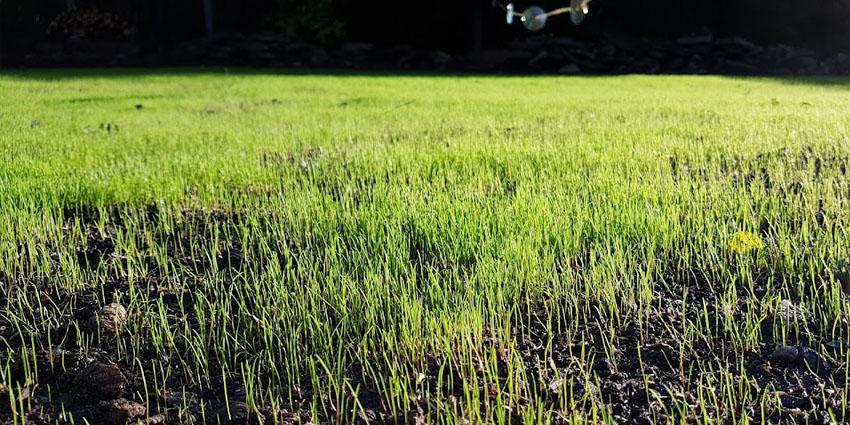
Created By
Matt Adams
Updated On
- March 14, 2024
Get FREE Exclusive Access
Keep your lawn pristine with exclusive tips, offers and insights that I only share with my private subscribers.
Latest Posts
How to care for a new lawn – mowing, watering & feeding tips
- By Matt Adams
- March 14, 2024
Jump to
Get FREE Exclusive Access
Keep your lawn pristine with exclusive tips, offers and insights that I only share with my private subscribers.
It’s easy to think that once you’ve created a new lawn, it will just look after itself. The truth is, if you have just done so, you’re journey into lawn care is only just beginning.
That’s why I wrote this post. It goes hand in hand with my other post ‘How to care for your lawn year round’. In this post though, I’m focusing purely on a new lawn. I’ll answer questions like when you should first mow a newly seeded lawn and which feed products to use. I’ll also touch on watering, the benefits of a roller and which products will help you care for your new lawn.
So, let’s get going. The first thing that’s probably on your mind is…
When to do the first cut of a new lawn

You should wait until the grass blades have grown to approximately 3 inches long. Here’s a bit more on that.
Mowing is often seen as one of those things that you just do because you have to. But believe it or not, there are a few important guidelines to follow, that will help keep your lawn looking lush, thick and fresh.
Another myth is that you should base your mowing depending on how much time has passed e.g. once a week or once every 2 weeks. But you should really base your momwing on the length of the grass blades.
So, Whether you have laid new turf or sown grass seed, you should wait until the blades are approximately 3 inches long (that’s just over 7.5 cm in modern UK terms).
One more thing on mowing.
How low should you go?
Another thing to note. it’s best to only trim 1/3 of the blade at any one time. That’s because every time you mow, the lawn needs to recover itself and if you go lower, the roots struggle to fend for themselves as they need the green blades to absorb the 3 main things for photosynthesis – carbon dioxide, water and oxygen.
What to feed your new lawn
One thing I didn’t realise is that the feeding doesn’t stop after the seed has germinated. In fact if you keep on top of your own feeding programme, you will give your lawn a huge chance of looking it’s best for years to come.
If you did a bit of research, you probably gave your fresh seed or turf some pre turf / pre seed fertiliser. So, before you add another granular feed, you want to be sure that the nutrients have been used up.
You can however apply a liquid feed to help the give the turf or newly germinated seed a boost.
Here’s where I recommend you begin. The following tips are only recommended if you lay your new turf or seed your soil in Spring and Summer. If you do it in the Autumn (also a great time of year foe new lawns) then you should be okay to wait until the following Spring to start your lawn care. Have a read of my article ‘how do I take care of my lawn year round?’
Apply a liquid seaweed feed
Applying a liquid seaweed to a new lawn will benefit the grass in a few ways. Firstly, it will promote microbial activity in the soil which is hugely beneficial for the grass.
It will also give your new blades a lush green colour – not only making it look great, but also making it perfect for stripes.
TRG’s Liquid Seaweed is also 100% organic, so as a bonus you will be doing your bit for the environment.
Depending on how early in the Spring or Summer your lawn is in fruition (of course if it’s turf, it will be quicker to establish) then you will want to apply a liquid seaweed every 6 weeks, without going past September.
Your New Lawn Watering Programme
The intensity of your watering will differ depending on whether you had turf laid or sowed seed. Let’s start with how to water your new lawn if you have sown seed.
Watering seed and newly germinated seed
During the first 2 weeks of germination, you should make sure the ground is moist everyday. That means if there’s no rain, then you should water twice a day for approximately 5-10 minutes.
After the first 2-3 weeks, and when most of the seed has started to shoot up, you can reduce your watering cycle.
Watering newly laid turf
I know I said turf and seed are different when it comes to watering. But, in truth, theya re quite similar. It’s easy to think that if you lay turf, then you don’t need to do as much watering as seed.
In fact, you should making sure that your newly laid turf is fully watered every day for the first 2-4 weeks
Why so much watering for turf?
The most important thing is that the new lawn is able to merge itself with the old/current top soil. And to do that it needs water. It also has shallow roots so these roots need something to help them grow again.
Pre seed fertiliser will help toward giving your new turf soe strong roots but those roots will also need water to truly establish themselves as part of the ground.
If you want to know more about watering turf, have a read of this article.
When can you walk on your new lawn?
If you want your new turf to establish itself well, then the less wear it gets, the better. Of course if you need to walk on it then so be it. but it’s probably best to wait around 3 weeks before you take the giant leap and walk on the grass.
In regards to seeding a new lawn, then you will want to minimise foot traffic as much as possible. You should also try to minimise pets and kids playing on the lawn for at least the first month while the seed germinates and the roots settle in.
Should you roll a new lawn?
The biggest benefit you get from rolling a lawn is more of an aesthetic one than actually giving any benefit to the grass itself.
That’s because rolling up and down in opposite directions will create the ever yearned for stripes. One tip I’d give you is to buy a lawn mower with a rear roller, that way you can have the stripes created while trimming the grass.


This Post Has 2 Comments
When May I apply fertiliser to a newly overseeded lawn? And which? Thanks in anticipation. Martin
You can apply fertiliser at the same time as seeding. I usually recommend using a pre-seed fertiliser if it’s applied just before or after seeding.